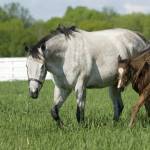Waiting for the Foal: Determining Gestational Length in Mares

What’s worse than waiting for water to boil or for a red light to turn green? That’s right, waiting for your mare to foal! Despite multiple foaling prediction methods, contraptions, and gizmos, the truth is, the foal will only come when it’s ready and not one minute sooner.
One research group* recently reviewed data on gestational length in horses. According to that report, most knowledge on the subject was generated more than 50 years ago.
Old data determined that normal equine gestational length was 340 days. This value remains the standard today despite the fact that average was created by studying only Thoroughbred mares residing in northern European countries.
Since those inaugural studies, we now know that geography, breed, sex of foal, mare genetics, month of conception, and a myriad of other factors influence gestational length.
“An improved grasp of breed-specific gestational lengths in well-defined geographical regions would help veterinarians recognize and diagnose premature and dysmature foals,” explained Laura Petroski, B.V.M.S., a veterinarian for Kentucky Equine Research.
Being able to determine a foal’s degree of prematurity and dysmaturity (born after an apparently appropriate gestational length but immature) at or soon after birth based on gestational length and physical examination findings would help identify and possibly correct a variety of conditions associated with being born too early.
“Premature and dysmature foals often have incomplete ossification of the carpal and tarsal bones, meaning that the small, cuboidal bones in the knees and hocks do not form properly. Such foals are at risk for developing associated conditions as they age such as bone malformation and fracture, angular limb deformities, and degenerative joint disease,” Petroski said.
These bone abnormalities can cause lameness in horses and lead to an early retirement from athletic pursuits.
“Although equine parturition and neonatal outcomes will always be subject to a degree of variability unrelated to gestational dates, a reduction in young stock requiring surgical intervention for potentially career-ending angular limb deformities could potentially benefit the industry in terms of economics, as well as equine health and welfare,” the researchers said.
Ensuring a broodmare’s overall health and body condition before and during gestation will support a healthy pregnancy and minimize the chances of difficult births. Further, supplementing mares with omega-3 fatty acids such as EO•3, a potent marine-derived oil rich DHA and EPA, benefits not only reproductive efficiency but also joint and respiratory conditions.
“Consult with a KER nutrition advisor with any specific questions you have about your broodmare’s diet at any point during gestation,” recommended Petroski.
*Clothier, J., G. Hinch, W. Brown, et al. 2017. Equine gestational length and location: Is there more that the research could be telling us? Australian Veterinary Journal 95(12):454-461.








